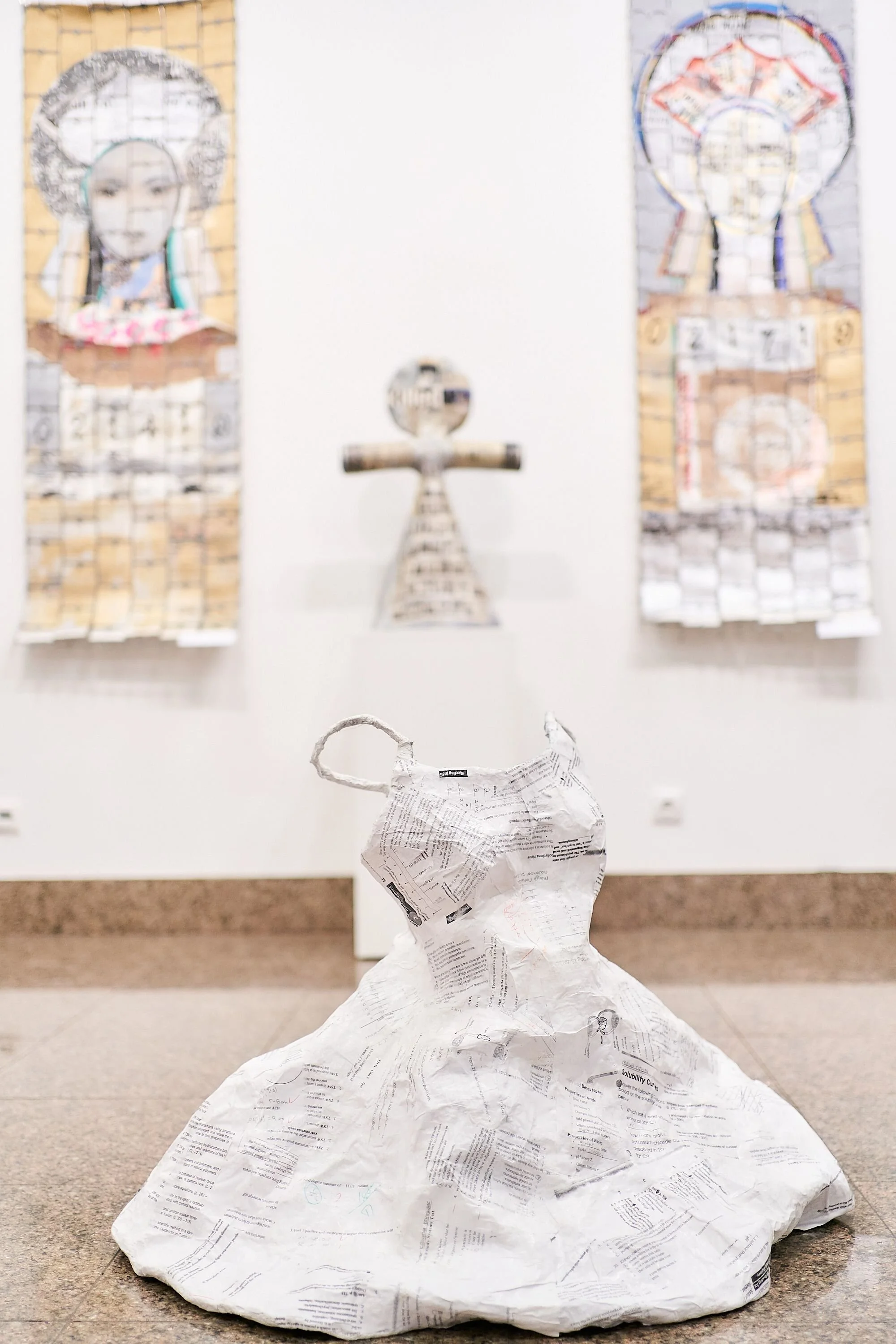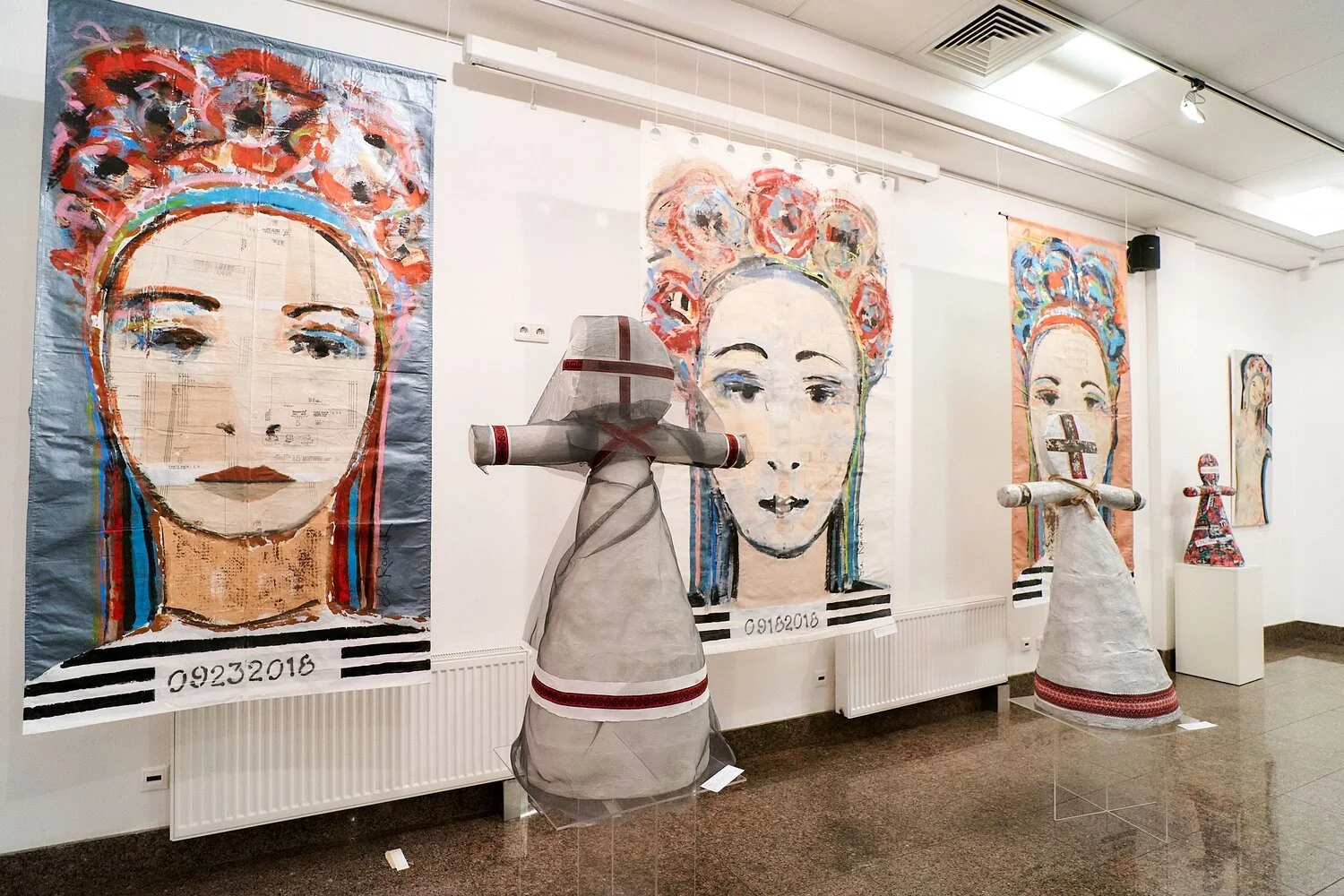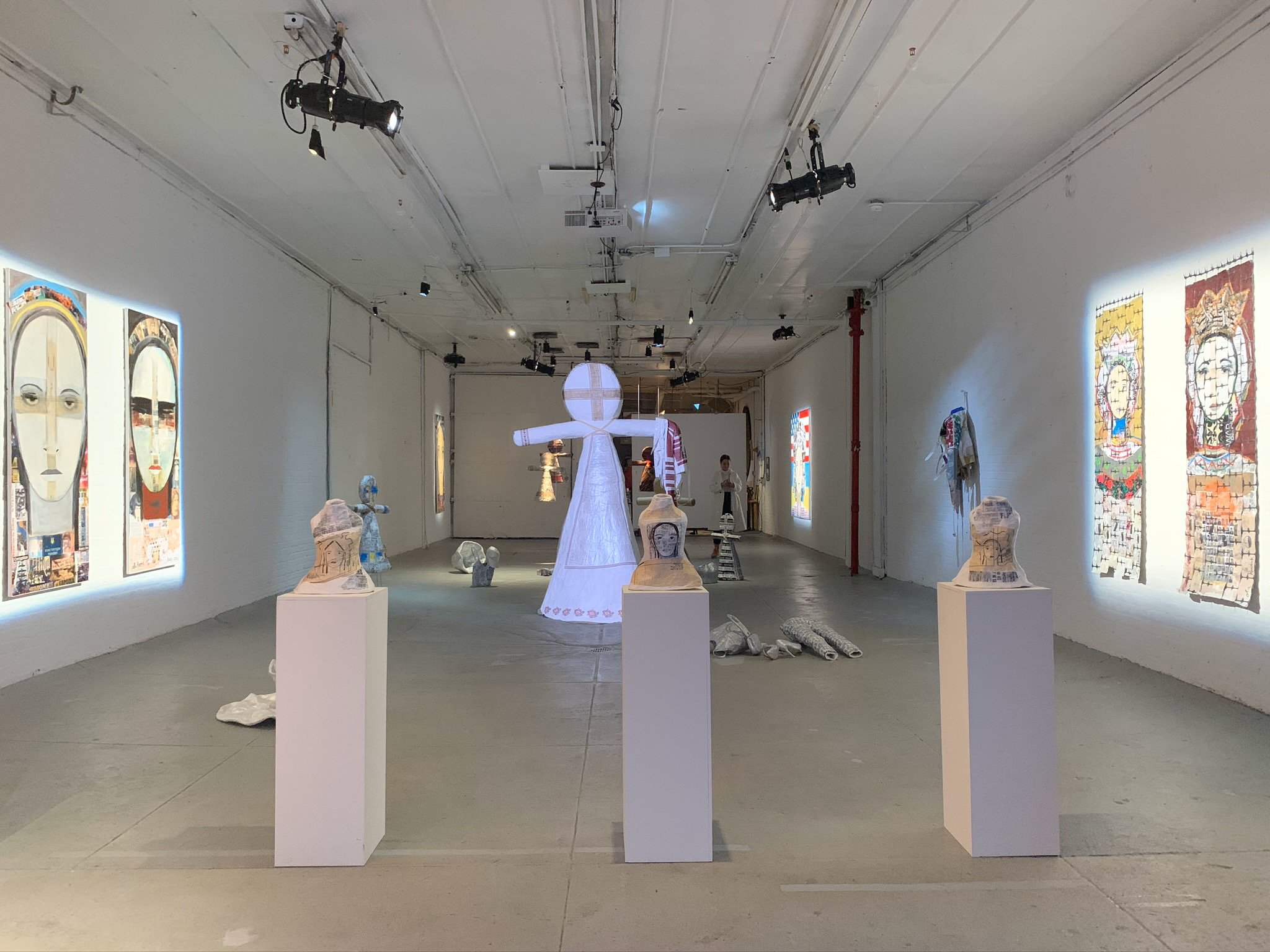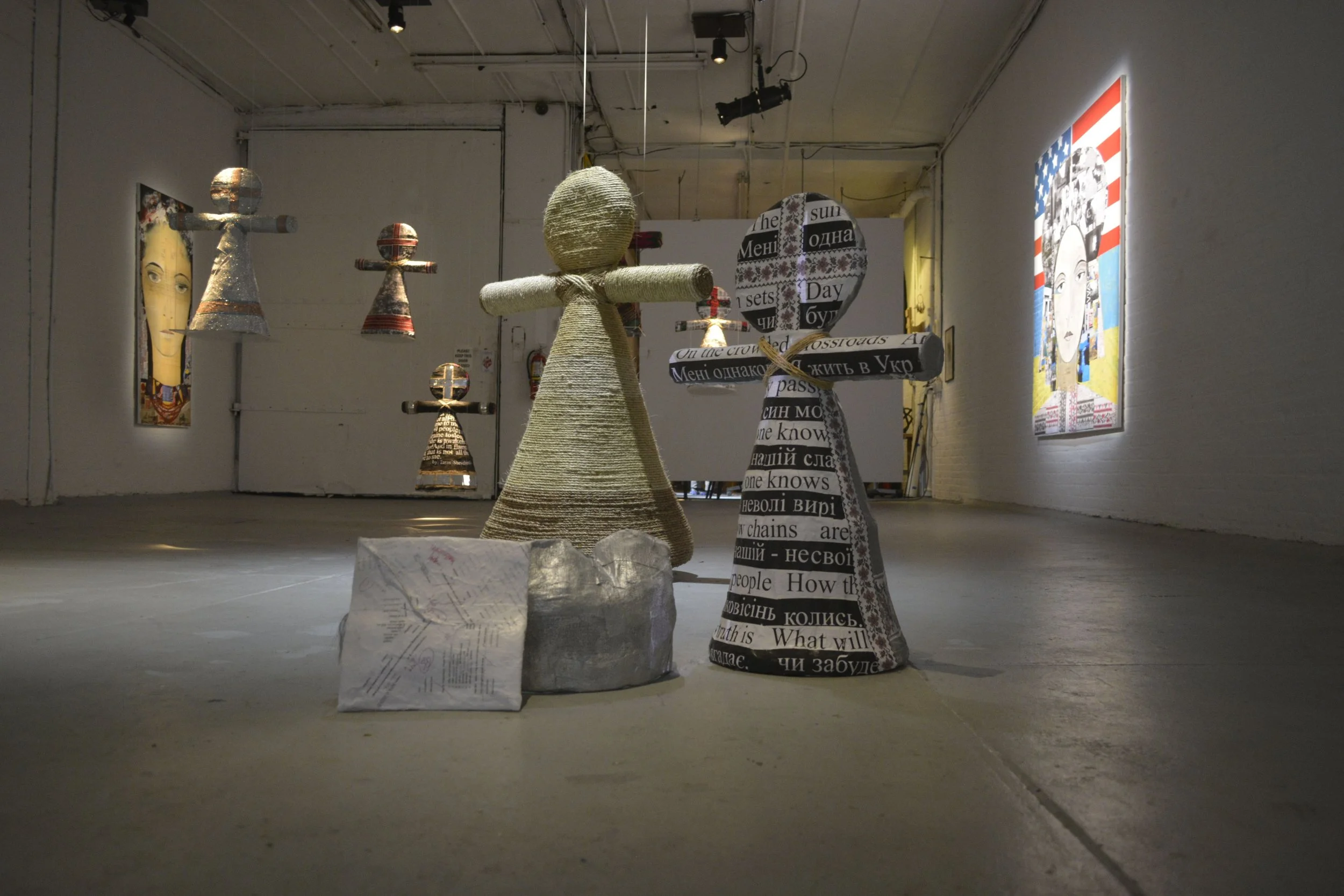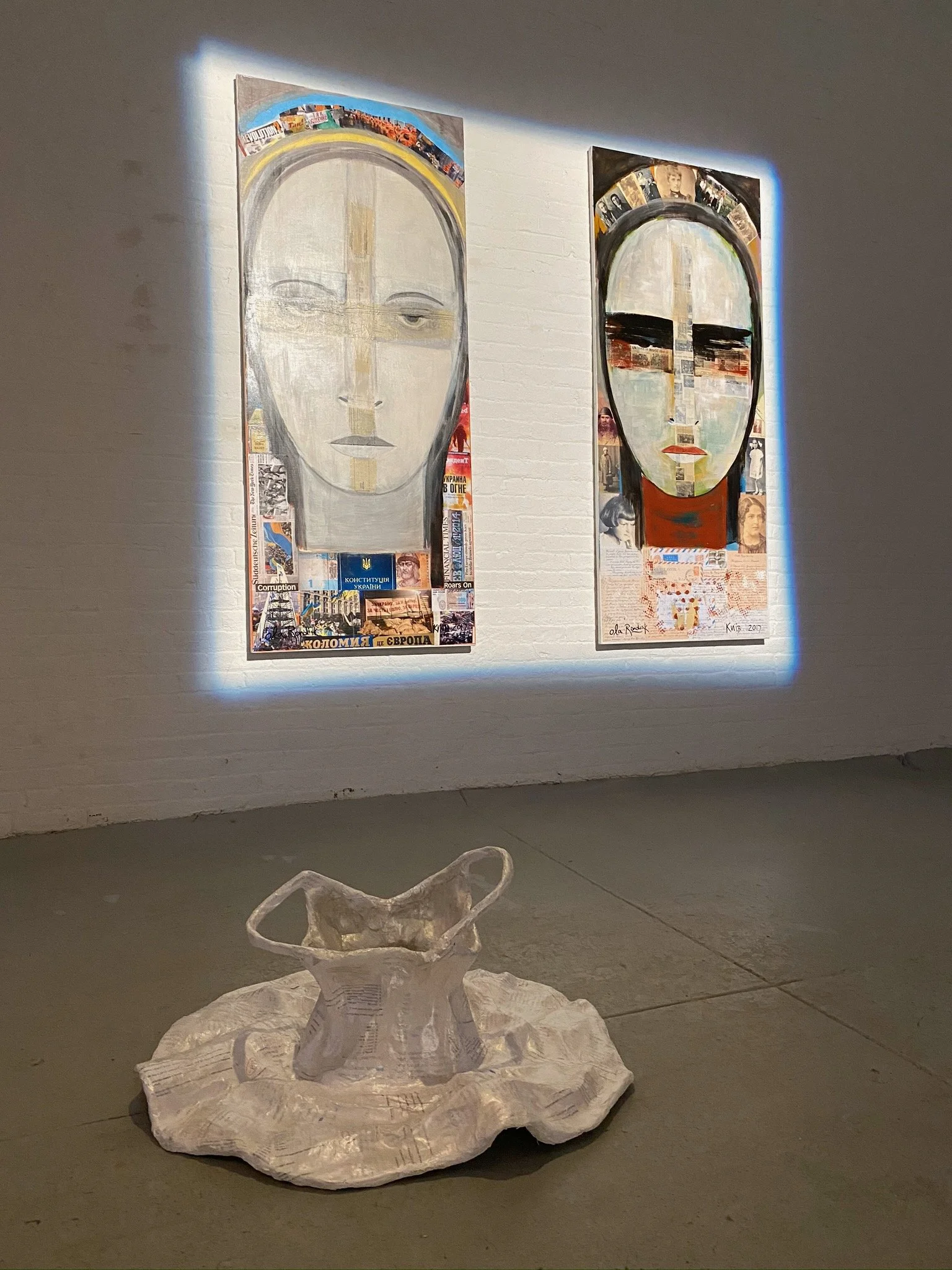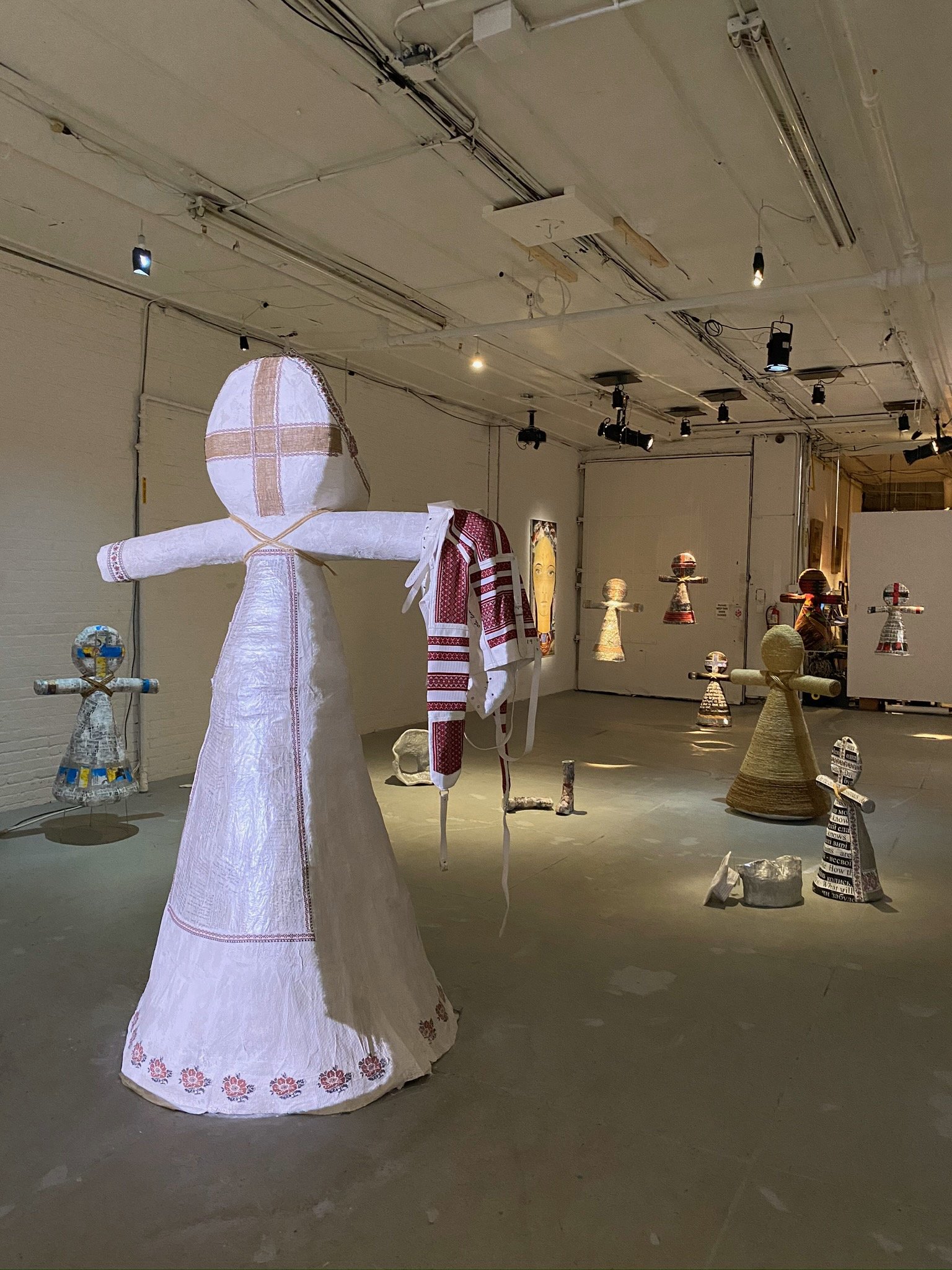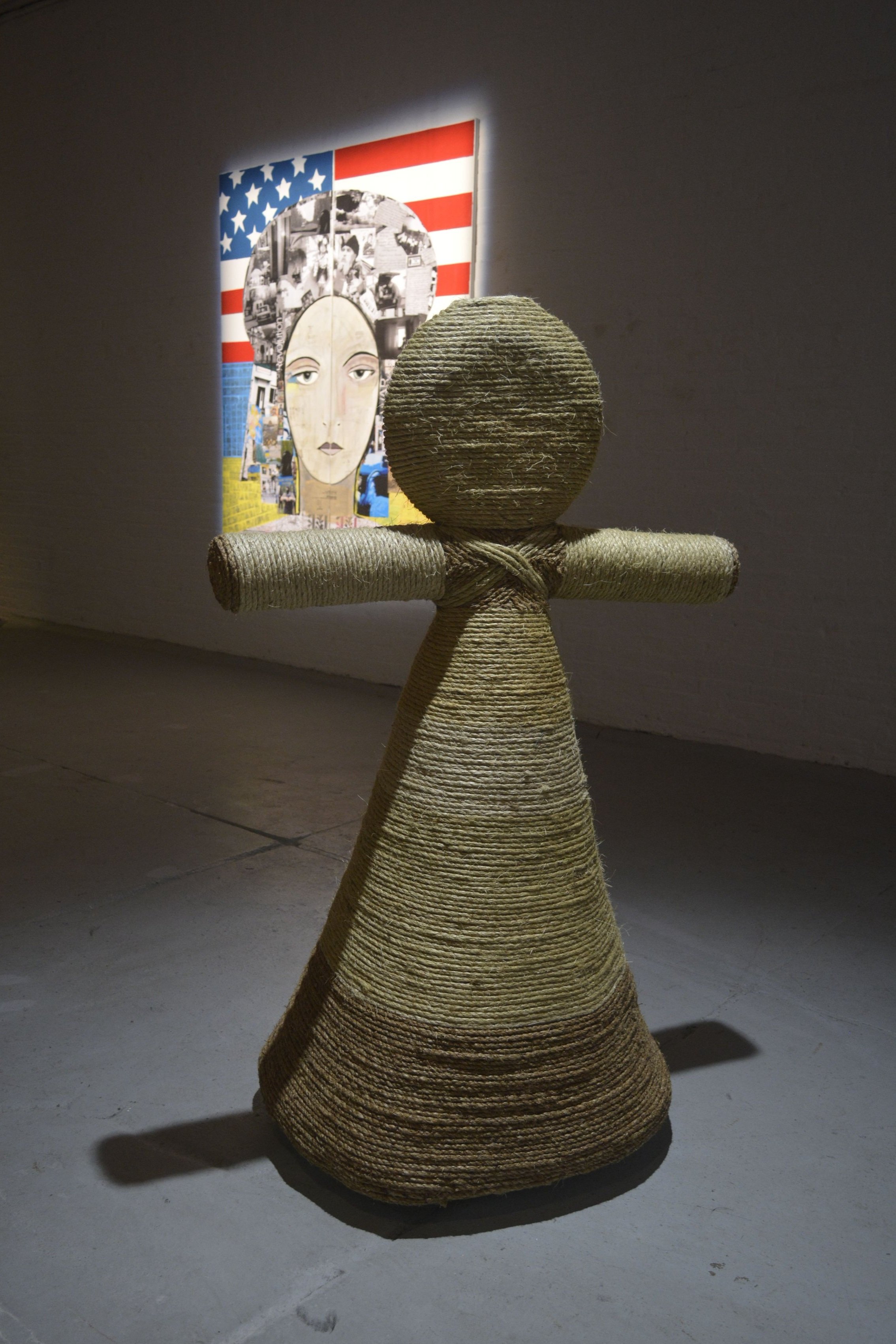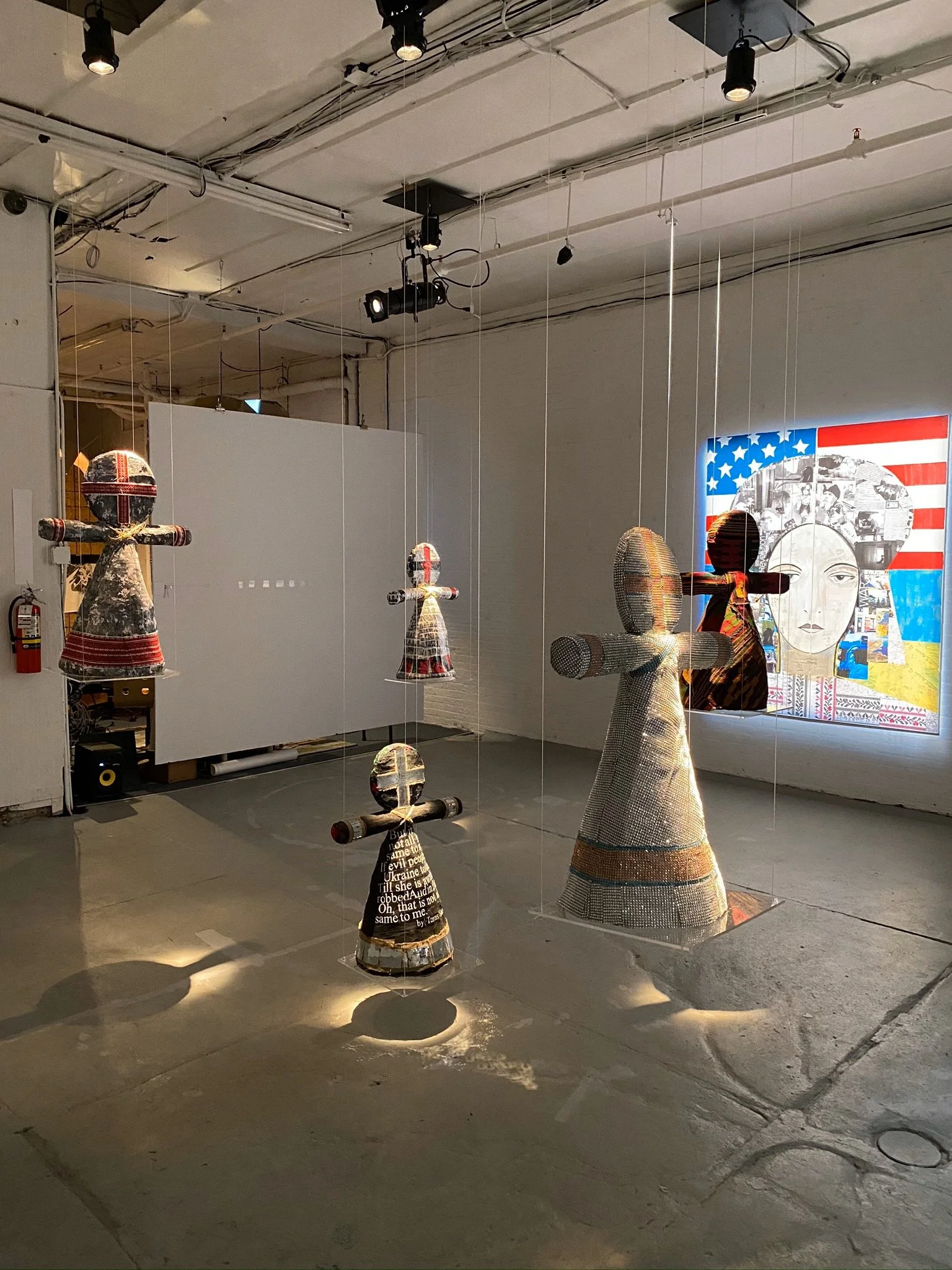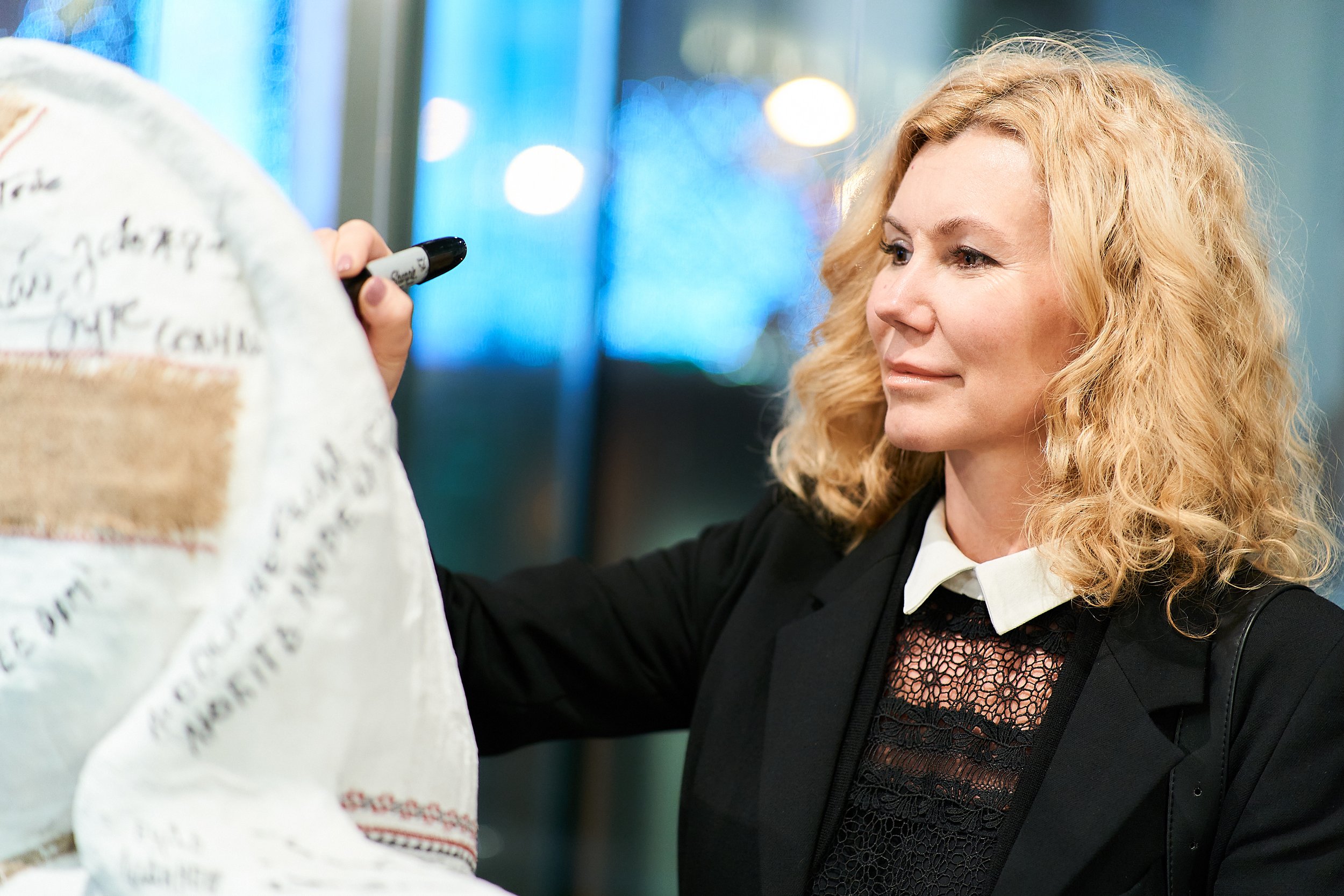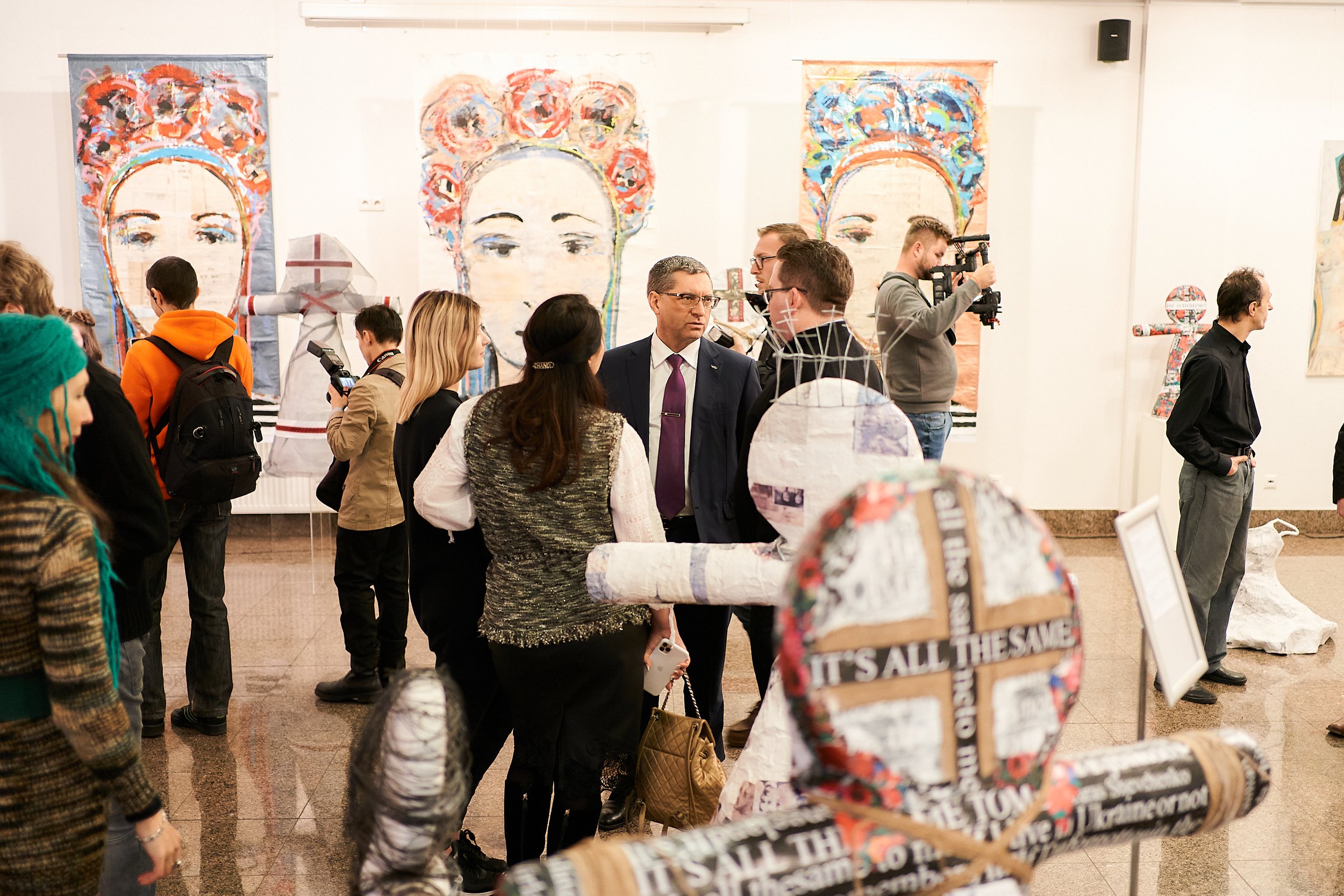Metempsychosis (2020)
Curatorial Statement
Written by Juan Puntes (Founder and Artistic Director of WhiteBox-Harlem)
Born in Ohio, steeped in Ukrainian culture at birth, as a Ukrainian American emigrè artist caught in the tumultuous times in the midst of an unprecedented, surreal spiderweb condition Ukraine and the US find themselves in today—a sort of gridlock of phantasmagoric proportions—reasons aside, Ola Rondiak, a devotee of being an artist of the day, uses the paleontology of recent history as the grit to grind towards becoming free from the burden of her beloved Ukraine’s fettered, conditioning history.
With a clinical eye and passion, the artist manipulates her laboriously culled, extensive informative materials, personal and cultural. Through the use of pure history as foil, she gains an introspective look into her adoptive country’s present-day quandaries. Examining sententious historical premises found in Ukraine’s ample and at times disturbing socio-political field, she distills those materials into arresting, familiar images for her audiences’ consideration. Thus, arriving into a freshly owned narrative, Rondiak is able to guide the viewer to better understand, if not comprehend entirely, her complex premises’ tortuous nuances. Grabbing from her tool box an instrument to cut through time and space, she lands the viewer—if a bit fictitiously or theatrically—inside a ‘moment in time’ that may transport her or him inside affected days sheathed in the first concept of the Ukrainian nation, late 1700s, newly coming lose from three empires as illuminated in the “Eneyida”; the roots of Ukraine augur present day’s unraveling? A déjâ-vu to tinker with embedded in Rondiak’s work? Let’s not forget the artist subscribes to the fact art ought to impulse, precipitate a questioning in the viewer, no more and no less.
Twenty years since emigrating from the US, and fully integrated into the fabric of ‘Ukrainianness’—away from the ‘Russianness’ she encountered upon arrival—Rondiak, as an artist, finds herself oddly enough at a crossroads where part of her local art-scene colleagues tend to see her artwork leaning too heavily upon the past, urging her to ‘modernize’ her approach. It kind of brings an echo of the disdain certain Parisian School artists had for the simple, sumptuous historical looking sculpture of Modigliani, today revered, yesteryear tossed into the Seine out of frustration. Rondiak’s dissenting art folk seem to partake in the belief—perhaps a sedative, coping pill for their own discomfort with history—that in order to be contemporary, one needs to ‘leave the past behind’ entirely, that building imagery ringing of a more affable ‘globalized-anodized’ sensation is superior, hipper than a finely researched, personal and socially meaningful impactive imagery found in Rondiak’s work.
As suggested by the exhibition title’s amalgam, metempsychosis or ‘meta-in-soul’, Rondiak’s puzzling visual materials are inseparable from her own direct—end in itself—experience, today pertinently expressed in her oeuvre in what amounts to regaling the viewer with a rare ‘art with a historical conscience’.
The exhibition will include three steps/movements in New York and two in Kyiv. Rondiak’s Motankas are fashioned after the talismanic, traditional Ukrainian Dolls meant to protect a child from from evil spirits and to restore health. She began to build them inspired solely upon discovering her grandmother’s miraculously made—and survived—motankas made while held prisoner in a concentration camp. Shocking and heartening at once to Ola, the image of granny’s feat, and her dedicated labor of manufacturing something valuable, healing, out of practically nothing in a materially denuded place‑save for her gathering thread out of blankets for this process—instilled in her a deep devotion for this spiritual craft, honoring grandma’s accomplishment in conjuring up health and safety for her imprisoned comrades and missing family. Several of those motankas made it out of the liberated camp alive and well, eventually finding their way to be exhibited in Chicago. In New York only, a second step/movement to be exhibited paralleling the motankas can be seen in the form of recent Neo-Pop sculptures made out of the artist’s worn-out, preserved children’s clothing. Invested with plaster of Paris for rigidity, coated with layers of semi-transparent paper maché retaining on their surfaces legible markings of early homework, storied drawings, youthful family tales and visual doodles, this body of recent work represent a direct testament of better times arrived, a fresh notion of passing time while morphing histories. A third step/movement to be showcased in both exhibitions takes the form of large ultra-flat paintings derived from Byzantine Medieval to early Renaissance mural painting. They are infused with a local shared symbology imbued with historical resonance, made contemporary by the use of minimal post Post-Modernist techniques—as in Alex Katz’s works, the all female subjects share a melancholic innuendo, though in this instance proud, stoic, smile-less women, made more regal, impersonal looking, by the relentless harshness and deprivation endured by these folk during decades of constraining Soviet rule and later indoctrination of ‘Russianness’, today still resonant in some quarters.
“In Rondiak’s ouevre, the dots are not only connected, they are hardwired with Ukrainian history.”
Thus the ‘lives’ or periods of Rondiak’s artmaking in Ukraine remain immersed in the cauldron of highly volatile historicities.
In New York her art will inspire and open windows of curiosity in the viewer, particularly given the present day preoccupation regarding both countries’ status and mutual commitments or lack thereof. In Kyiv, the audiences’ scrutiny will have them analyze, perceive and bring to mind strong, unavoidable images reminding them of familiar ‘transitional forces’ allied of decidedly personal as well as communal/national memories heavily inscribed in their psyche.
A history not understood and digested calls for repeat performance. In analyzing Rondiak’s works, an ominous onus hides in and is aired out in hopes of mitigating, to any extent, the multiple pressures her beloved Ukraine is under at present. We must not forget the artist is a trained psychologist caught between two strains, the ‘then’ and the ‘now’ in front of a third column, her acute analytical purview reaching deep in her inner sanctum, chewing on the fiber of ‘who’ she is in this grand ‘giocco’ as an artist assuaging the torn filaments of history anew. Anew in order to decipher her imminent social and artistic identity, her potential powers of persuasion and influence, her measuring of to what degree an artist can contribute to the birth of the new while leaning on the past for good measure. Purely naked in front of a rather debatable history, showered here and there by certain antagonism towards her methodology, the artists’ oeuvre incisively speaks for itself to those willing to hear and witness her explicit path laid out for the viewer to recognize and navigate a turbulent, shared history in flux.
Exhibited simultaneously at WhiteBox-Harlem in NYC and the Museum of Kyiv History in Kyiv, Ukraine (sponsored by the Revolution of Dignity Museum).
Installation Photos
Event Photos
Panel Discussion
A two city Public Panel discussion between The Revolution of Dignity Museum in Kyiv and WBX Harlem hosted by the Ukrainian Congress Committee of America in the East Village and The Maidan Museum in the Trades Union Building.
Panelists: Kathy Natlywajko, Moderator | Ola Rondiak, Artist | Masha Turchinsky, Director, Hudson River Museum | John Varoli, Media & Communications advisor | Vladislav Sludskiy, Curator | Maria Shust, Director of The Ukrainian Museum
Exhibition Videos
Select Exhibition Locations:
WhiteBox-Harlem (New York City, U.S.A)
Museum of Kyiv History (Kyiv, Ukraine)
For information about upcoming exhibits and events, connect with us.
